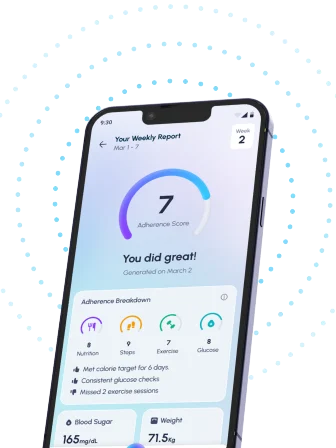Table of Contents
- Diabetes Nutrition: Mastering Blood Sugar Control
- Your Guide to Healthy Eating with Diabetes
- Diabetes-Friendly Recipes: Delicious & Blood Sugar Balanced
- Understanding Carbohydrates and Diabetes Management
- Create a Personalized Diabetes Meal Plan
- Frequently Asked Questions
- References
Living with diabetes doesn’t mean sacrificing delicious food! In fact, understanding Diabetes Nutrition is key to managing your blood sugar and enjoying a healthy, vibrant life. This blog, Diabetes Nutrition: Your Guide to Healthy Eating and Blood Sugar Control, is your ultimate resource for navigating the world of diabetes-friendly recipes, meal planning, and practical tips. We’ll demystify the complexities of carbohydrate counting, explore the benefits of specific foods, and empower you to make informed choices that support your overall well-being. Get ready to discover how delicious and manageable diabetes management can truly be!
Diabetes Nutrition: Mastering Blood Sugar Control
Managing diabetes, especially in tropical climates common to many Indian and other regions, requires a nuanced approach to nutrition. A significant portion of the global diabetic population – 61% are aged between 20-64 years, while 39% are 65+ years old, according to the IDF Diabetes Atlas – highlighting the importance of lifelong dietary management, starting early. This means focusing on easily accessible, culturally relevant foods.
Prioritizing Whole Foods
Focus on whole grains like brown rice, millets (ragi, jowar, bajra are popular in India), and whole wheat roti instead of refined carbohydrates. Incorporate plenty of fruits and vegetables abundant in these regions, such as mangoes, papaya, leafy greens, and various legumes. These foods provide essential vitamins, minerals, and fiber, helping regulate blood sugar levels. Remember to be mindful of portion sizes.
Managing Carbohydrate Intake
Carbohydrates are essential, but portion control is key. Learn to estimate carbohydrate servings and distribute them evenly throughout the day. Prioritize low-glycemic index (GI) foods, which release sugar more slowly into the bloodstream. This helps prevent sudden spikes in blood sugar. Spices common in Indian cuisine, like cinnamon and turmeric, may also offer added benefits. As you age, managing carbohydrates becomes even more critical. For insights on this, check out our blog on Managing Diabetes as You Age: Challenges and Solutions.
Hydration and Healthy Fats
Stay well-hydrated, especially in warmer climates. Choose healthy fats like those found in nuts, seeds, and avocados, in moderation. These fats contribute to satiety and can help regulate blood sugar levels. Avoid excessive consumption of saturated and trans fats often found in processed foods. It’s also important to remember that managing cholesterol is crucial when dealing with diabetes. Learn more about this in our article, How to Manage Cholesterol Levels with Diabetes?
Consult a Registered Dietitian
For personalized guidance tailored to your specific needs and cultural preferences, consult a registered dietitian. They can help you create a diabetes-friendly meal plan that incorporates local, readily available ingredients, ensuring effective blood sugar management and a healthy lifestyle. This is particularly crucial given the diverse dietary habits across Indian and tropical countries.
Your Guide to Healthy Eating with Diabetes
Managing diabetes in hot and humid climates like those found across India and other tropical countries requires a nuanced approach to nutrition. Maintaining stable blood sugar levels is crucial, and a well-planned diet plays a vital role. A common guideline suggests aiming for 45–60 grams of carbohydrates per meal, though this can vary significantly depending on individual factors like activity levels, medication, and overall health. It’s essential to consult with your doctor or a registered dietitian to determine the right carbohydrate intake for you.
Understanding Carbohydrate Intake
Carbohydrates are a key factor in blood sugar control. Understanding how different carbohydrate sources affect your blood sugar is vital. Prioritize complex carbohydrates like whole grains (brown rice, millets like ragi and jowar, which are staples in many Indian diets), legumes (lentils, beans), and vegetables over refined carbohydrates found in white bread, sugary drinks, and processed foods. These complex carbs are digested more slowly, leading to a gentler rise in blood sugar.
Incorporating Regional Foods
Many traditional Indian and tropical dishes are naturally well-suited for diabetes management. Think of dishes featuring plenty of vegetables, lentils, and lean proteins. Spices like turmeric and cinnamon, commonly used in Indian cuisine, also have potential anti-inflammatory benefits. However, be mindful of portion sizes and added sugars, fats, and oils.
Practical Tips for Blood Sugar Control
* Prioritize fiber-rich foods: Fiber slows down the absorption of sugar, helping to prevent spikes in blood sugar. Fruits, vegetables, and whole grains are excellent sources.
* Choose lean protein: Protein helps you feel full and satisfied, preventing overeating. Good choices include fish, poultry, legumes, and nuts.
* Limit saturated and trans fats: These unhealthy fats can negatively impact your blood sugar control and overall health.
Remember, consistent monitoring and a personalized approach are key. Consult with a healthcare professional in your region to create a diabetes management plan tailored to your specific needs and dietary preferences. They can help you navigate the challenges of managing diabetes in your specific climate and cultural context. For more simple tips, check out 10 Proven Tips to Effectively Manage Diabetes | Simple Guide. Learning how to effectively manage your diabetes can significantly improve your quality of life, and understanding carbohydrate intake is a crucial first step. For a more comprehensive guide, see 10 Proven Tips for Effective Diabetes Management.
Diabetes-Friendly Recipes: Delicious & Blood Sugar Balanced
Managing Blood Sugar Through Delicious Indian & Tropical Cuisine
Maintaining healthy blood sugar levels is crucial for managing diabetes, aiming for pre-meal levels between 80–130 mg/dL and post-meal levels below 180 mg/dL. Fortunately, delicious and blood sugar-balanced meals are easily achievable using readily available ingredients in Indian and tropical regions. The key lies in focusing on complex carbohydrates, lean proteins, and healthy fats.
Recipe Ideas for Balanced Blood Sugar
Think vibrant and flavorful dishes! Instead of refined rice, opt for brown rice or millets like ragi or bajra, common and nutritious staples across the region. Incorporate plenty of leafy greens like spinach, amaranth, or moringa, packed with essential vitamins and minerals. Lean protein sources like lentils (dal), chickpeas (chana), and fish provide sustained energy without spiking blood sugar. Spice up your meals with turmeric, ginger, and cinnamon – known for their anti-inflammatory and blood sugar-regulating properties.
Sweet Treats with a Twist
Even desserts can be diabetes-friendly! Consider using natural sweeteners like jaggery or stevia in moderation. Fruits like mango, papaya, and banana, abundant in tropical climates, offer sweetness without excessive sugar spikes, but remember portion control. For more ideas on managing your diet during the holidays, check out our blog on Creating Diabetes-Friendly Dishes for the Holidays.
Localizing Your Diabetes-Friendly Diet
Explore the rich culinary heritage of your region to find delicious and healthy recipes. Experiment with local fruits, vegetables, and spices to create satisfying and blood-sugar-conscious meals. Remember consulting a doctor or registered dietitian for personalized dietary advice tailored to your individual needs and health status is crucial for effective diabetes management. For a comprehensive list of foods that are beneficial for managing diabetes, see our article on the 20 Best Foods for People with Diabetes.
Understanding Carbohydrates and Diabetes Management
Managing diabetes effectively in India and other tropical countries requires a deep understanding of carbohydrates and their impact on blood sugar levels. This is especially crucial given that over 60% of people with diabetes in India also have hypertension, highlighting the need for comprehensive health management. Understanding how different carbohydrates affect your blood glucose is key to preventing dangerous spikes. This is further complicated by the strong link between diabetes and obesity, a connection explored in more detail in our blog, Understanding the Link Between Diabetes and Obesity.
Types of Carbohydrates and Their Impact
Not all carbohydrates are created equal. Simple carbohydrates, found in sugary drinks, white bread, and sweets, are rapidly digested and cause a sharp rise in blood sugar. In contrast, complex carbohydrates, like whole grains, legumes, and most vegetables, are digested more slowly, leading to a more gradual and sustained release of glucose into the bloodstream. Choosing complex carbohydrates is crucial for stable blood sugar control.
Practical Tips for Carbohydrate Management
Prioritizing complex carbohydrates in your diet is a simple yet powerful step. Incorporate more whole grains like brown rice and millets, which are staples in many Indian and tropical diets. Increase your intake of lentils, beans, and vegetables. Pay attention to portion sizes, even with healthy carbohydrates, to avoid exceeding your daily recommended intake. Remember to check food labels carefully for hidden sugars. While diet is key, it’s also important to understand the role of supplements. Learn more about Safe and Effective Dietary Supplements for Diabetes Care.
Regional Considerations
Many traditional Indian and tropical diets already include a variety of complex carbohydrates. However, the increasing prevalence of processed foods and sugary drinks poses a significant challenge. By focusing on traditional, whole-food options and limiting processed foods, you can effectively manage your blood sugar levels and reduce your risk of complications like hypertension. Making informed choices about carbohydrates is vital for a healthier life.
Create a Personalized Diabetes Meal Plan
Understanding Your Needs
Managing diabetes, especially in hot and humid climates prevalent across India and tropical countries, requires a tailored approach to nutrition. The global burden of diabetes is staggering, with projections showing a rise from 536.6 million people (20-79 years) in 2021 to a projected 783.7 million in 2045. This highlights the urgent need for personalized diabetes management strategies. Your meal plan must consider your individual needs, activity levels, and the availability of fresh produce in your region.
Building Your Plan: Key Considerations
Portion control is paramount. Focus on smaller, more frequent meals to prevent blood sugar spikes. Prioritize whole grains like brown rice, millets (ragi, jowar), and whole wheat roti, staples in many Indian and tropical diets. Include plenty of non-starchy vegetables, such as leafy greens, gourds, and beans, rich in fiber and nutrients. Lean protein sources like lentils (dal), fish, and chicken are crucial for maintaining muscle mass and blood sugar stability. Fruits should be chosen carefully, paying attention to their glycemic index. Mangoes, for example, while delicious, are high in sugar and should be consumed in moderation. For more information on creating a comprehensive plan, see our guide on Personalized Diabetes Control: Your Key to Better Health.
Regional Adaptations
Incorporating readily available regional produce is key. Many tropical fruits and vegetables offer unique benefits. Think of incorporating spices like turmeric and cinnamon, known for their anti-inflammatory properties and potential benefits for blood sugar control. Consult a registered dietitian or diabetes educator familiar with your region’s dietary customs to create a meal plan that seamlessly integrates with your lifestyle and local food sources. Remember, consistent effort and personalized planning are vital for effective diabetes management. If weight loss is a goal, consider our tips on How to Lose Weight with Diabetes Diet Plan.
Frequently Asked Questions on Diabetes Nutrition
Q1. What is the best way to manage diabetes through diet, especially in tropical climates?
Focus on a diet rich in whole grains (like brown rice and millets), plenty of fruits and vegetables, and controlled portions of carbohydrates, choosing low-glycemic index options. Healthy fats from sources such as nuts, seeds, and avocados are important, while limiting saturated and trans fats. Prioritize complex carbohydrates over refined ones. Stay well-hydrated.
Q2. What are the benefits of following a diabetes-friendly diet?
A well-planned diet helps maintain stable blood sugar levels, reducing the risk of diabetes complications. It supports overall health and well-being.
Q3. Are there any specific foods I should include or avoid in my diet?
Include whole grains, fruits, vegetables, healthy fats, and spices like cinnamon and turmeric. Limit saturated and trans fats, and control portions of carbohydrates, especially refined ones. A registered dietitian can provide personalized guidance.
Q4. How can I get started with creating a diabetes-friendly meal plan?
Consult a registered dietitian to create a personalized plan that considers your individual needs, preferences, and cultural background. They can help you make sustainable dietary changes.
Q5. What role does portion control play in managing diabetes?
Portion control is crucial for managing carbohydrate intake and maintaining stable blood sugar levels. It helps prevent blood sugar spikes and contributes to overall weight management, which is important for diabetes management.
References
- A Practical Guide to Integrated Type 2 Diabetes Care: https://www.hse.ie/eng/services/list/2/primarycare/east-coast-diabetes-service/management-of-type-2-diabetes/diabetes-and-pregnancy/icgp-guide-to-integrated-type-2.pdf
- Children with Diabetes : A resourse guide for families and school. : https://www.health.ny.gov/publications/0944.pdf




